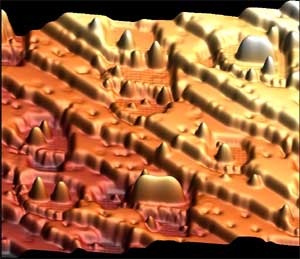| Apr 06, 2006 |
Scientists develop new way to explore and control atom-scale magnetism
|
|
(Nanowerk News) IBM scientists have developed a powerful new technique for exploring and controlling magnetism at its fundamental atomic level.
|
|
The new method promises to be an important tool in the quest not only to understand the operation of future computer circuit and data-storage elements as they shrink toward atomic dimensions, but also to lay the foundation for new materials and computing devices that leverage atom-scale magnetic phenomena.
|
|
"We have developed a window into the atomic heart of magnetism," said Andreas Heinrich, research staff member at IBM's >Almaden Research Center in San Jose, California. "We can now position atoms and then measure and control their magnetic interactions within precisely designed structures."
|
 |
STM image of 28nm by 28nm area of the terraced copper and copper nitride surface where the IBM experiments were performed. The smooth flat surfaces are copper metal; the cross-hatched, slightly depressed areas are patches of insulating CuN, which were created by implanting a sub-monolayer amount of nitrogen and heating the surface. The scientists wanted both sufaces close to each other so they could easy test magnanese-atom structures on both the conducting and insulating surfaces. The visible humps on the surfaces are the manganese structures (1-10 atoms long) (Source: IBM)
|
|
The new method, called spin-excitation spectroscopy, uses IBM's special low-temperature scanning tunneling microscope designed for use with a broad range of magnetic fields up to 140,000 times stronger than the earth's. The researchers first move atoms into position and then measure the interactions between their atomic spins, which are the fundamental sources of magnetism.
|
|
In their experiments, the IBM researchers created chains of up to 10 manganese atoms atop an extremely thin electrically insulating surface and measured how the magnetic properties changed as each new atom was added. They found that chains with an even number of atoms had no net magnetism, while chains with an odd number of atoms showed net magnetism.
|
|
"This kind of exploratory research is essential for the long-term future of the computer industry," said Gian-Luca Bona, manager of science and technology at IBM Almaden. "Sometime in the next couple of decades, it will be impossibly difficult to continue improving transistors and other traditional microelectronic circuit elements by simply shrinking them. We will then need alternative structures and, perhaps, altogether different ways of computing. Techniques like this can help us gain the knowledge needed to create those alternatives."
|
|
These new experimental results, titled "Spin Coupling in Engineered Atomic Structures" are published in the March 30, 2006 issue of Science Express. The report's authors are Cyrus Hirjibehedin, Christopher Lutz and Heinrich.
|
|
In addition to exploring the basic properties of magnetic materials, the IBM researchers expect to use this new technique in the future to:
|
|
• Explore the limits of magnetic data storage, by engineering the energy required to flip the collective orientation of a small number of magnetically coupled atoms.
|
|
• Determine the feasibility of spin-based wires and a spin version of the molecular-motion cascade, the group's 2002 achievement that included an arrangement of molecules that formed a working computer circuit some 260,000 times smaller than its conventional design in silicon (or about 50 years of circuit-shrinking at Moore's Law pace).
|
|
• Investigate how engineered spin interactions could be applied to quantum information systems, such as quantum computers.
|

